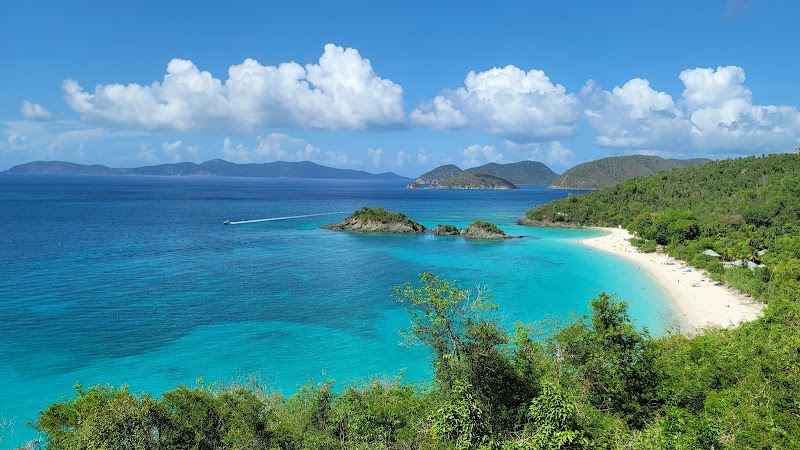Top Scenic Hikes and Hidden Beaches of Virgin Islands National Park: Exploring Western Saint John
Discover the scenic trails and secret beaches of western Saint John’s Virgin Islands National Park. This guide blends vivid experience with practical tips to help you plan hikes that reveal tropical forests, historic sites, and quiet coastal hideaways.
Hydrate Strategically
Bring at least 2 liters of water per person for hikes over 3 miles, especially during midday heat. Water refill options are scarce on trails.
Wear Supportive Footwear
Choose sturdy hiking shoes with good grip due to uneven coral rock and dirt paths common in Saint John’s trails.
Start Early
Begin hikes before 9 a.m. to avoid peak heat, allowing cooler temperatures and softer light for photography.
Respect Ocean Currents
Many western beaches have strong, unpredictable currents. Swim cautiously and avoid risky areas during rough conditions.
Top Scenic Hikes and Hidden Beaches of Virgin Islands National Park: Exploring Western Saint John
The western reaches of Virgin Islands National Park on Saint John offer a rugged invitation to explore sprawling trails and secretive beaches that push you into nature’s raw embrace. Trails like Reef Bay Trail stretch 3.4 miles with a manageable 700-foot elevation gain, wandering through shaded tropical forest where ancient petroglyphs silently guard the path and the coastline’s crash dares you forward. Expect rocky, sometimes uneven terrain demanding sturdy shoes and steady footing, but the reward is a secluded beach touched by turquoise waves where the currents quietly sculpt the sand.
For a slightly shorter venture, the 1.5-mile Cinnamon Bay Trail twists along dense greenery before popping out at Cinnamon Bay Beach—broad, white, and largely free from crowds in the early morning hours. The trail blends dirt paths and coral rock, making lightweight hiking shoes with good traction essential. Along the way, the trees sway with a confident rhythm, breeze teasing leaves as seabirds cut through the salty air.
To further challenge your adventurous spirit, take the 5-mile hike to Larsen Bay via the Lameshur Bay Trail. It gains roughly 800 feet elevation over rocky stretches and offers panoramic views of the Caribbean’s expanse, reminding you that this landscape is fiercely itself, not to be rushed or underestimated. Time your start to avoid the afternoon heat, carry plenty of water, and prepare for a mix of sunlit breaks and shady covers.
The hidden beaches in this western sector defy crowds and commercialization, each shaped by currents and sun, offering quiet refuge. Honeymoon and Maho Bays, while better known, still maintain intimate corners worth seeking out, especially during shoulder season. They need respect: currents here push strongly, and beachcombing calls for attentiveness.
Approach these adventures with preparation: hydration packs accommodate long hikes, moisture-wicking layers handle humidity, and early morning or late afternoon starts dodge tropical heat spikes. Weather can shift swiftly, so a lightweight rain jacket is prudent. Keep your camera ready; moments of clarity against storm-cloud contrasts or sun piercing through cloud breaks compose stunning images.
The challenge is less about conquering nature and more an exchange — an understanding that the trails and shores, deeply alive, will test patience and attention. But the payoff is experiencing land and sea as active participants, not just a background. Pack your resolve along with essentials, and Saint John’s western wilds won’t just invite you in — they’ll engage you in their fierce, unyielding rhythm.
Nearby Trips
All Adventures
Boat Charters
Water Activities
Adventures near Cruz Bay
Discover the unique and memorable adventures that make Cruz Bay special.
Frequently Asked Questions
Are the beaches along these hikes safe for swimming?
Many western beaches have variable currents, which can be strong and unpredictable. Stick to designated safe swimming areas such as Cinnamon Bay and Maho Bay, and always check current conditions on-site before entering.
Can I find shade along these trails?
Most western trails offer significant canopy cover through tropical forest. However, some coastal stretches expose you to direct sun, making proper sun protection and hydration vital.
Are there any cultural or historical sites along the hikes?
Yes. For example, Reef Bay Trail features ancient Taino petroglyphs etched into rock faces along the path—remnants of indigenous cultures that deepen the sense of place here.
What wildlife might I encounter?
Look for lizards sunning on rocks, various seabirds gliding overhead, and occasionally small tropical birds flitting through the understory. Marine life can also be visible from beaches and rocky outcrops.
Is entrance to Virgin Islands National Park required?
Yes. There is a national park entrance fee that supports preservation efforts. It’s usually included in ferry tickets or car rentals but check current rates before arrival.
Are dogs or pets allowed on these trails?
Pets are generally not allowed within Virgin Islands National Park to protect native species and maintain trail integrity.
Recommended Gear
Hydration Pack
Keeps you hydrated and hands-free during long hikes, especially in hot and humid conditions.
Sturdy Hiking Shoes
Provides stability on rugged coral and dirt paths and prevents injury on uneven terrain.
Lightweight Rain Jacket
Protects against sudden tropical showers without adding weight or bulk.
Wide-Brimmed Hat
Offers sun protection during exposed sections of trail and beach stops.
Local Insights
Hidden Gems
- "Petroglyph sites along Reef Bay Trail"
- "Secluded shorelines at Lameshur Bay"
- "Quiet tide pools along the Cinnamon Bay coastline"
Wildlife
- "Brown pelicans"
- "Virgin Islands tree lizard"
- "Frigatebirds"
- "Rare endemic orchids in forest undergrowth"
History
"Saint John’s western trails pass through former plantation lands and sites where indigenous Taino people once thrived. These lands carry stories layered with colonial history and environmental resilience."

